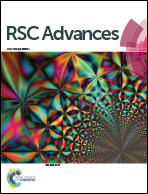Comparative study on the characteristics, operational life and reactivity of Fe/Cu bimetallic particles prepared by electroless and displacement plating process†
Abstract
In this study, an electroless (electrode-less) copper plating technology was developed to prepare the high-reactive and robust iron–copper (Fe/Cu) bimetallic particles. First, effect of pretreatment and key preparation parameters (e.g., complexant, H3BO3, NiSO4·7H2O, pH and plating time) on the reactivity of Fe/Cu bimetallic particles were investigated, respectively. Their reactivity was evaluated according to the obtained Kobs for PNP removal. Also, the characteristics of Fe/Cu bimetallic particles prepared by electroless plating and displacement plating were comparatively observed by scanning electron microscopy (SEM), energy dispersive X-ray spectroscopy (EDS) and X-ray photoelectron spectroscopy (XPS). The analysis results show that when Fe/Cu bimetallic particles were prepared by electroless plating, copper was uniformly deposited on the surface of Fe0 substrate, and only a few bulky particles were observed. However, plenty of loose copper blocks were heterogeneously distributed on the surface of Fe0 substrates when the Fe/Cu bimetallic particles were prepared by the conventional displacement plating. Furthermore, the operational life and reactivity of Fe/Cu bimetallic particles prepared by electroless and displacement plating process were comparatively investigated by the recycling experiment. The results suggest that the new Fe/Cu bimetallic particles have a longer operational life than that of the conventional Fe/Cu bimetallic particles. Meanwhile, it can be seen from the control experiments that the new Fe/Cu bimetallic particles have a stronger reactivity for the PNP removal both in Fe/Cu/air and Fe/Cu/N2 processes. As results, the new electroless plating for the preparation of Fe/Cu bimetallic particles is superior to the conventional displacement plating. In other words, the electroless copper plating is a promising technology to prepare the high-reactive and robust Fe/Cu bimetallic particles.


 Please wait while we load your content...
Please wait while we load your content...